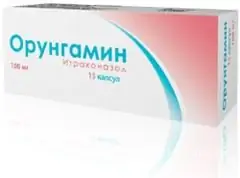- Author Rachel Wainwright [email protected].
- Public 2023-12-15 07:39.
- Last modified 2025-11-02 20:14.
Orungamin
Instructions for use:
- 1. Pharmacological action
- 2. Release form
- 3. Indications for use
- 4. Contraindications
- 5. Method of application
- 6. Side effects
- 7. Storage conditions
Prices in online pharmacies:
from 105 rub.
Buy

Orungamin is a broad-spectrum antifungal synthetic agent.
pharmachologic effect
The active substance of Orungamin has an antifungal effect due to its ability to suppress the synthesis of ergosterol in the membrane of fungal cells.
According to the instructions, Orungamin is active against dermatophytes, yeasts and yeast-like fungi:
- Microsporum spp.;
- Cryptococcus neoformans;
- Candida spp., Including Candida glabrata, Candida albicans, and Candida krusei;
- Histoplasma spp.;
- Sporothrix schenckii;
- Cladosporium spp.;
- Blastomyces dermatitidis;
- Fonsecaea spp.;
- Aspergillus spp.;
- Epidermophyton floccosum;
- Trichophyton spp.;
- Pityrosporum spp.;
- Paracoccidioides brasiliensis.
Release form
Orungamin is available in capsules with a pink transparent body and a blue cap, containing 100 mg of the active ingredient itraconazole in the form of light yellow microgranules. 5 or 15 pieces per pack.
A number of analogs of Orungamin are also produced - capsules Itrazol, Irunin, Itraconazole, Miconichol, Rumikoz, Teknazol, Canditral, Orunit, Orungal, Itraconazole, Orungal oral solution and Irunin vaginal tablets.
Indications for the use of Orungamin
The drug and analogues of Orungamin are used to treat:
- Dermatomycosis;
- Pityriasis versicolor;
- Candidomycosis affecting the mucous membranes or skin, including vulvovaginal candidiasis;
- Fungal keratitis;
- Deep visceral candidiasis;
- Onychomycosis, which is caused by molds, dermatophytes, or yeasts.
In addition, Orungamin is prescribed according to the instructions for the treatment of systemic mycoses:
- Systemic aspergillosis and candidiasis;
- Histoplasmosis;
- Paracoccidioidomycosis;
- Cryptococcosis, including cryptococcal meningitis;
- Blastomycosis;
- Sporotrichosis;
- Other tropical or systemic mycoses.
Contraindications
According to the instructions, Orungamin is contraindicated to take:
- With chronic heart failure;
- Under the age of three;
- With hypersensitivity to itraconazole;
- Simultaneously with dofetilide, sertinol, astemizole, levacetylmethadol, bepridil, terfenadine, mizolastine, lovastatin, cisapride, pimozide, quinidine, simvastatin;
- Simultaneously with preparations containing nisoliptin, ergot alkaloids, eletriptan;
- With fructose intolerance, glucose-galactose malabsorption, as well as with sucrase deficiency.
During pregnancy and lactation, Orungamin is approved for use with caution according to strict indications.
Method of application of Orungamin

To achieve the optimal therapeutic effect, Orungamin capsules are recommended to be taken immediately after meals.
The dose of the drug and the duration of treatment depends on the fungal infection:
- With vulvovaginal candidiasis, the drug can be taken according to two schemes: 2 capsules twice a day for one day or one capsule of Orungamin once a day for 3 days. Also for the local treatment of vulvovaginal candidiasis, including recurrent, you can use the analogue of Orungamin - Irunin in the form of vaginal tablets;
- With pityriasis versicolor, treatment is usually carried out for a week, taking 2 capsules once;
- With dermatomycosis of smooth skin, Orungamin can be used according to the treatment regimen for pityriasis versicolor, or take one capsule for 15 days;
- With fungal keratitis, treatment is usually longer and is three weeks, 2 capsules per day;
- For oral candidiasis, Orungamin is said to be effective when taken one capsule per day for 15 days;
- With onychomycosis, Orungamin, according to the instructions, is taken for three months, 1 capsule per day or two capsules twice a day for a week, after which the course is repeated after a break of 3 weeks. As a rule, for the treatment of onychomycosis of the feet, three courses of treatment are necessary, for brushes, two are enough;
- The duration of treatment for systemic mycoses varies from two to twelve months, depending on the pathogen. The recommended dosage is 1-2 capsules of Orungamin 1-2 times a day.
In case of impaired immunity, for example, with neutropenia or AIDS, the dose of the drug or Orungamin analogues should be doubled. In case of renal and hepatic insufficiency, an increase in the dose may also be required.
According to the instructions, Orungamin should be taken with caution at the same time as:
- Calcium channel blockers - dihydropyridine and verapamil;
- HIV protease inhibitors - indinavir, ritonavir, saquinavir;
- Some anticancer drugs - docetaxel, pink vinca alkaloids, trimetrexate, busulfan;
- Oral anticoagulants;
- Some immunosuppressants - tacrolimus, cyclosporine, sirolimus;
- Other drugs - reboxetine, digoxin, ebastine, carbamazepine, methylprednisolone, buspirone, rifabutin, alfentanil, brotizolam, alprazolam.
When using proton pump inhibitors or histamine H2 receptor blockers, take Orungamin capsules with acidic drinks.
In cases of taking Orungamin for more than one month, it is recommended to monitor liver function.
Side effects of Orungamin
When using Orungamin, according to reviews, side effects are extremely rare. Most often they manifest as a violation of taste, headache, abdominal pain, vomiting, rash and diarrhea. Somewhat less often, Orungamin, according to reviews, can cause:
- Neutropenia, leukopenia, thrombocytopenia;
- Angioneurotic edema, hypersensitivity;
- Pollakiuria, urinary incontinence, menstrual irregularities, erectile dysfunction;
- Swelling;
- Peripheral neuropathy, paresthesia, dizziness, hypesthesia;
- Toxic epidermal necrolysis, pruritus, Stevens-Johnson syndrome, erythema multiforme, leucoclastic vasculitis, exfoliative dermatitis, urticaria, photosensitivity, alopecia;
- Myalgia, arthralgia;
- Hyperbilirubinemia, dyspepsia, acute liver failure, constipation, hepatitis, hepatotoxicity;
- Visual impairment, including blurry and diplopia, as well as transient or permanent deafness, tinnitus;
- Hypokalemia, hypertriglyceridemia;
- Serum sickness, anaphylactic and anaphylactoid reactions;
- Pulmonary edema.
In cases of neuropathy and heart failure, it is recommended to stop taking the drug.
Storage conditions
Orungamin is a Schedule B antifungal with a shelf life of 36 months and is available by prescription.
Orungamin: prices in online pharmacies
|
Drug name Price Pharmacy |
|
Orungamin 100 mg capsule 4 pcs. RUB 105 Buy |
|
Orungamin 100 mg capsules combi-pack 1 + 1 4 pcs. 183 r Buy |
|
Orungamin 100 mg capsule 14 pcs. 410 RUB Buy |
|
Orungamin 100 mg capsule 15 pcs. 584 r Buy |
|
Orungamin capsules 100mg 14 pcs. 715 RUB Buy |
|
Orungamin 100 mg capsule 42 pcs. RUB 1499 Buy |
|
Orungamin 100 mg capsules combi-pack 1 + 1 42 pcs. 1665 RUB Buy |
|
Orungamin capsules 100mg 42 pcs. (combi packing 1 + 1) 1714 RUB Buy |
| See all offers from pharmacies |
Information about the drug is generalized, provided for informational purposes only and does not replace the official instructions. Self-medication is hazardous to health!






